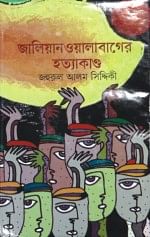|
Book Review
Humanity in Peril
Aantaki Raisa
 |
Jalianwalabager Hatyakanda
(A History of massacre at Jalianwalabag)
By Zahrul Alam Siddique
Publisher: Muktadhara
Pages: 108, Price: Tk 120, Genre: History |
Jalianwalabager Hatyakanda depicts the savage carnage carried out by the British “gentleman” in charge Edward Harry Dyer on April 13, 1919 at the Baisakhi fair in Amritsar, Punjab. The writer, Zahrul Alam Siddique, not only delineates the atrocity of the massacre, he also renders the suppression of the British Raj of the people of the then Indian subcontinent, the circumstances under which the genocide was conducted and the events following that ghastly episode.
On April 13, 1919, thousands of people from and around Amritsar gathered to participate in the Sikh religious festival Baisakhi. Those innocent and unarmed men, women and children were ruthlessly murdered by the British-Indian army commanded by Brigadier-General Dyer. Though, according to the official report the casualty numbered 397, some other sources claim it to be as high as 1000. But numbers or a one-line statement of the occurrence can never provide the horrid essence of the genocide. That's where this book comes handy. It starts with an explicit description of the Jalianwalabag massacre. Then it takes the reader to the background of the event and eventually the story moves forth to the inevitable consequences of the genocide.
We are more or less familiar with the history of the subcontinent during the British Raj and how the subcontinent earned its independence from the British rule. What many of us do not know is the small but significant events which triggered the urge for freedom among the masses, what had led the peaceful people of the subcontinent to become resistant to the British government, or to become violent and angry. This book tells the moments of history in making, the almost forgotten events that had actually motivated and sometimes forced the people to stand for their rights, to fight against discrimination and oppression. The author does not only explain the internal events of the subcontinent that had eventually drawn the path of freedom, he also depicts the influence of international events such as the First World War and the Balkan War in the course of our colonial history. But while explaining the circumstances of the time, the author does not digress from the main story that he conveys-- the massacre of Jallianwala Bagh. The events of the book revolve around the massacre and the life of the man who conducted it.
Unlike most of the history books, Jalianwalabager Hatyakanda is written in a story-telling manner. Instead of just describing the events, the author has put in intriguing and exciting conversations of the protagonists and the antagonists of the mass upsurge of that time. Instead of just telling the accounts of the major and well-known events of this history, he has compiled scads of interesting facts from the colonial history of the subcontinent that had shaped the future of the resistance of the masses against colonial suppression. Another engaging attribute of the book is that, it's never possible to predict what is coming in the following chapter. Each chapter of the book takes the reader to a brand new dimension, yet keeps the story coherent and synchronised.
The author, Zahrul Alam, who has mostly written for children, has written the book in a simple yet informative way. The gravity and the atrocity of the situations described in the book can be understood and felt by the readers of any and every age group. The book is worth a read not just because of its articulate simplicity, it's also a great resource to go beyond our history of 1971 and truly understand how we became a nation. To understand the birth of Bangladesh, we first need to know the birth of Pakistan. And to know the birth of Pakistan, we must know the colonial period and the disintegration of the subcontinent. The massacre of Jallianwala Bagh is a red letter day in the colonial history of the subcontinent and the book explores the nooks and crannies of the events surrounding it.
Copyright
(R) thedailystar.net 2010 |
| |
